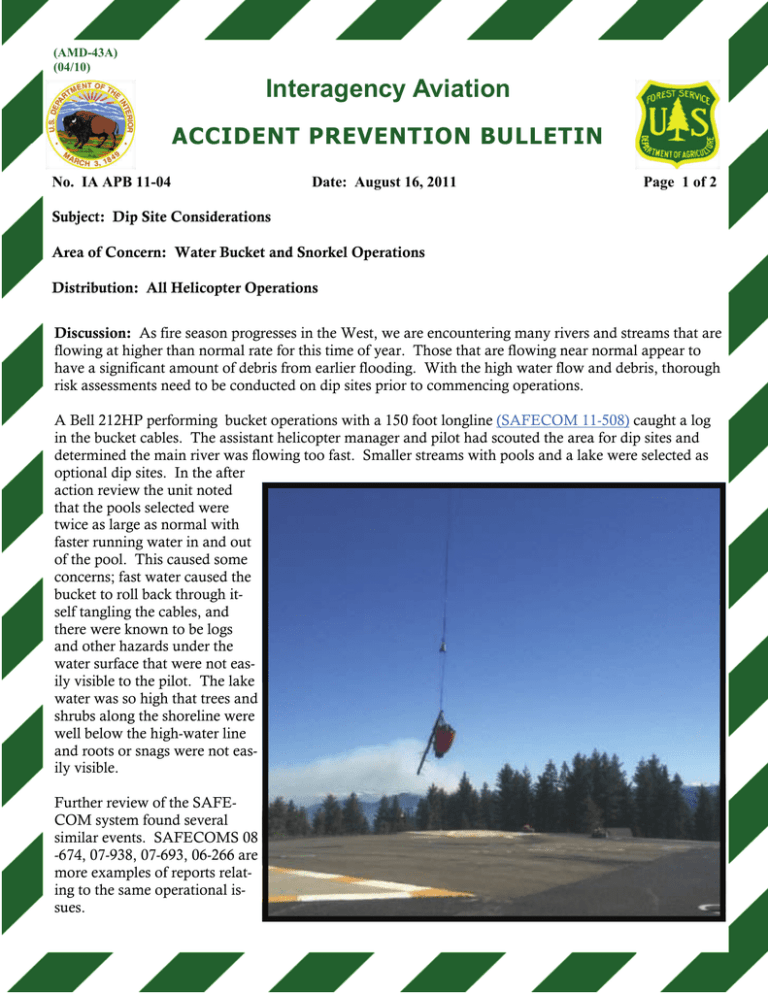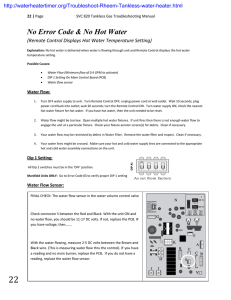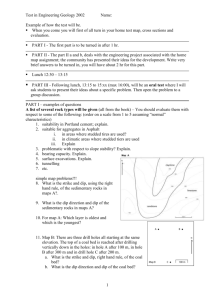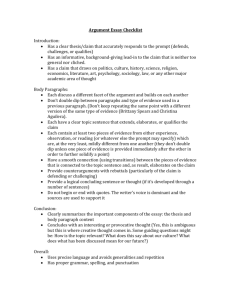Interagency Aviation ACCIDENT PREVENTION BULLETIN
advertisement

(AMD-43A) (04/10) Interagency Aviation ACCIDENT PREVENTION BULLETIN No. IA APB 11-04 Date: August 16, 2011 Page 1 of 2 Subject: Dip Site Considerations Area of Concern: Water Bucket and Snorkel Operations Distribution: All Helicopter Operations Discussion: As fire season progresses in the West, we are encountering many rivers and streams that are flowing at higher than normal rate for this time of year. Those that are flowing near normal appear to have a significant amount of debris from earlier flooding. With the high water flow and debris, thorough risk assessments need to be conducted on dip sites prior to commencing operations. A Bell 212HP performing bucket operations with a 150 foot longline (SAFECOM 11-508) caught a log in the bucket cables. The assistant helicopter manager and pilot had scouted the area for dip sites and determined the main river was flowing too fast. Smaller streams with pools and a lake were selected as optional dip sites. In the after action review the unit noted that the pools selected were twice as large as normal with faster running water in and out of the pool. This caused some concerns; fast water caused the bucket to roll back through itself tangling the cables, and there were known to be logs and other hazards under the water surface that were not easily visible to the pilot. The lake water was so high that trees and shrubs along the shoreline were well below the high-water line and roots or snags were not easily visible. Further review of the SAFECOM system found several similar events. SAFECOMS 08 -674, 07-938, 07-693, 06-266 are more examples of reports relating to the same operational issues. No. IA APB 11-04 Date: August 16, 2011 Page 2 of 2 Recommendations: * Use local knowledge for dip site selection. * Utilize dip site managers whenever possible and ensure they have radio contact. * Helicopter managers need to discuss with the pilots their comfort level with dip sites and if improvements are needed. * Conduct thorough reconnaissance; include a broader look at the water area so all potential obstacles are addressed and ensure safety circle compliance if descending below canopy. * Define parameters for dip site acceptability based on your assessment of the risks from winds, debris, swift water, etc. Ensure all personnel using the dip site understand and operate within those parameters. * Look for pools near the sides of the rivers or streams where flow rate is lower. * Carefully evaluate pools that are developed upstream from debris build-up. * In extremely high water conditions ensure that the dipsite is free of debris and the bucket is kept away from the water inlet and the outlet where debris may have settled. * Control the bucket depth throughout the dip cycle, do not allow the bucket to sink below the water- line to the point that obstacle avoidance cannot be assured. * Consider alternatives to the risk of fast water (i.e. setting up folding tanks, pumpkins, etc.) Please contact your agency helicopter inspector pilots if you have any questions or concerns regarding dip site operations. /s/ Ron Hanks Ron Hanks /s/ Keith Raley Keith Raley Branch Chief, Aviation Safety Management Systems, USFS Chief, Aviation Safety & Program Evaluations, DOI








![[#FWDIP-74] PVSS invalid Bits (including range) are not all reflected](http://s3.studylib.net/store/data/007282728_1-8b675e5d894a5a262868061bfab38865-300x300.png)